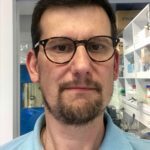Link to Pubmed [PMID] – 16365034
J. Biol. Chem. 2006 Mar;281(10):6413-27
AIF is a main mediator of caspase-independent cell death. It is encoded by a single gene located on chromosome X, region q25-26 and A6 in humans and mice, respectively. Previous studies established that AIF codes for two isoforms of the protein, AIF and AIF-exB. Here, we identify a third AIF isoform resulting from an alternate transcriptional start site located at intron 9 of AIF. The resulting mRNA encodes a cytosolic protein that corresponds to the C-terminal domain of AIF (amino acids 353-613). We named this new isoform AIFshort (AIFsh). AIFsh overexpression in HeLa cells results in nuclear translocation and caspase-independent cell death. Once in the nucleus, AIFsh provokes the same effects than AIF, namely chromatin condensation and large scale (50 kb) DNA fragmentation. In contrast, these apoptogenic effects are not precluded by the AIF-inhibiting protein Hsp70. These findings identify AIFsh as a new pro-apoptotic isoform of AIF, and also reveal that the first N-terminal 352 amino acids of AIF are not required for its apoptotic activity. In addition, we demonstrate that AIFsh is strongly down-regulated in tumor cells derived from kidney, vulva, skin, thyroid, and pancreas, whereas, gamma-irradiation treatment provokes AIFsh up-regulation. Overall, our results identify a novel member of the AIF-dependent pathway and shed new light on the role of caspase-independent cell death in tumor formation/suppression.
